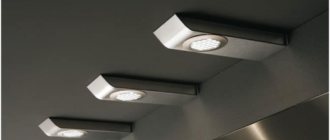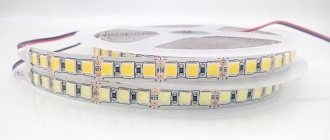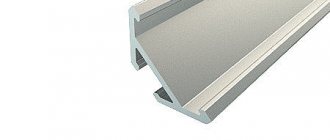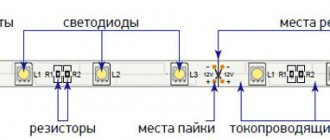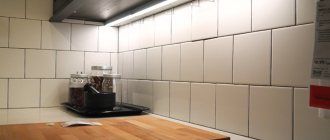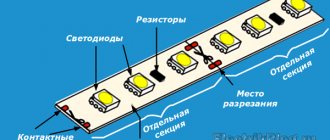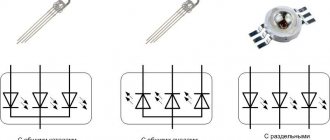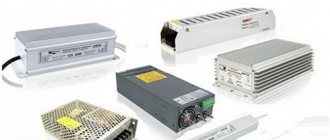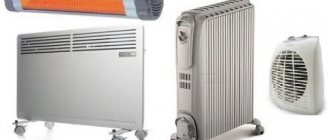- How to choose a profile for an LED strip?
- Types of profiles for LED strip
Specialized profile - Scope of application
- Why do you need a profile for LED strips?
- How to attach a profile for an LED strip?
Surface mount Recessed mount Pendant mount - Profile components
Tips for choosing
The LED strip profile is designed for mounting LED lighting on facades, cornices, signs and shop windows where an even strip of light is required. Thanks to the aluminum profile, plastic screen and side plugs, the backlight becomes protected from moisture, low temperatures and mechanical damage. You can select mounts and buy LEDs in Moscow in the LedRus online store.
How to choose a profile for an LED strip?
The profile for the LED strip is an aluminum box in which the LED strip is mounted on an adhesive basis and covered with a protective screen. It is also possible to install decorative end caps.
The LedRus store receives an assembled LED lamp, but if desired, you can replace the tape installed in the box. This allows you to change the brightness of the lamp - from a decorative glow to high-brightness light. The housing protects the LEDs from mechanical damage, and acts as a heatsink to remove heat well. The matte screen smoothes out the spot light from the diodes, creating a more uniform illumination strip.
Using the profile, you can assemble a lamp of any length, color and luminous power, not limited by the range of suppliers. The only question that remains is which profile is better for the LED strip. The choice of variety depends on the type of diode strip, as well as on the place where the structure will be fixed.
Tips for choosing
Key points to consider:
- Width. It forms the width of the light strip.
- Width of the site. It is worth considering the size of the tape, because not all wide ones can fit in the case.
- Screen view. Matte plastic for smooth light or clear for brighter lighting.
- Installation method. The design can be built-in, overhead or suspended.
- Coating. The aluminum surface can be unpainted, or it can be colored by anodizing or painting.
Price
The price of a branded aluminum profile for an LED strip is comparable to the price of the strip itself. As a result, the total cost of a lamp using a branded profile becomes quite significant. This point is the main obstacle to their widespread distribution. Nevertheless, there is still a demand for original products.
The products of the Polish manufacturer Klus are very popular. The huge range of profiles is further expanded by a variety of colors. For example, mortise models of the PDS4-K series can be ordered in silver, black and light gold, costing about 400 rubles per meter.
The profile with a minimum recess of the OPAC-30 series, in addition to the main colors, can be made in brown shades, but for an additional fee. Basic equipment will cost approximately 580 rubles/m.
Klus profiles of a more sophisticated shape with a ribbed back surface are designed for simultaneous installation of several LED strips and cost from 600 rubles. Corner KOPRO 30 (approximately 650 RUR/m) is made of thick aluminum with radiator fins, which allows it to provide more efficient heat dissipation for the LED strip.
The TRIADA overhead or hanging profile (RUB 1,300/m) consists of three paired guides, in each of which you can stick a tape of the desired color.
The prices for profiles for LED strips from Klus are indicated without a diffuser screen. Its average cost is 110–140 rubles per meter. In addition, you will need fittings in the form of simple and conductor plugs, which simplify installation and supply of power wires. All in all, it's not cheap. But the user always has the opportunity to purchase the necessary spare parts if the need arises. Products from Chinese manufacturers have a lower price category. For example, the well-known international brand for the production of LED products Arlight. On average, their products are 15-20% cheaper than Klus and also come with accessories. For example, WIDE-B-H20 measuring 20*11.5 mm can be found for 320 rubles per meter. It is compatible with two types of screens: rounded and rectangular with a matte and transparent surface. In a store, for example, the beloved Leroy Merlin, you can stumble upon an LED profile of unknown origin. The name of which consists of a set of letters and numbers. If the profile has an attractive price, then you should first carefully inspect it before purchasing. The surface must be anodized. Otherwise, the aluminum will remain unprotected, be susceptible to scratches and darken over time. It is recommended to pay special attention to checking the diffusing screen - it must have a uniform shade.
The cost of a profile indicated on the seller’s website does not always imply a complete set. What does it mean? In an attempt to attract buyers, stores often indicate the price not of the entire product (standard length is 2 meters), but per linear meter, without mentioning this on the main page.
You can also find a product whose price is given without taking into account the diffusing screen.
Types of profiles for LED strip
Basically, lamps are formed with aluminum profiles. They differ in shape, method of fastening and area of use. The material of construction should hold its shape well and bend a little.
According to the installation method, they are distinguished: built-in, suspended (ceiling), overhead and universal, with a section in the shape of a rectangle, square, circle, triangle (corner) or other geometric shape.
Specialized profile
It differs from standard lamps in its large dimensions (from 25-30 mm); it usually has a shelf or compartment for installing a power supply. This allows it to be installed internally without external power supplies.
Special profiles are used for:
- The steps in cinemas are L-shaped, into which anti-slip inserts are installed. To illuminate the plastic row numbers, there is a place for installing a single-row tape, which is covered with a powerful screen with great thickness to drown out the light.
- Edge lighting of glass. The design provides space for installing a tape on top of which the glass is installed. Thus, the tape shines at the end and on the other side this light is visible along the contour.
- Creation of linear and shaped lamps in a design room.
- Handrail lights.
What are the types?
Built-in (or mortise) profile for LED strip
This variety is an excellent solution. With its help, it becomes possible to combine drywall with chipboard. — LED strip — is located exactly in the area of this very connection. The design has an edge that covers all the irregularities in the grooves. This is one of the main differences between this profile and others. Thanks to it, the tape does not fall into the illuminated area of space.
Overlay profile for LED strip
This type is the most widespread and most popular, primarily due to ease of installation. Its principle allows the profile to be mounted on a variety of surfaces. You can install it using self-tapping screws or glue. This type is used to decorate arches, hemispherical elements and round shapes.
Corner profile for LED strip
It is often considered a type of overhead, but its areas of application are corners, the space next to them and places where a specific degree of lighting is needed. On the outside, the walls of the structure are placed at an angle of 90 degrees relative to each other. There are specially made grooves on their edges to accommodate the diffuser for the LED strip. At an angle of 45 degrees, inside the diffuser there is a shelf for gluing LED strips.
In operating mode, the light flow is scattered precisely at a given angle, and not in one plane, illuminating the entire space.
- Parts made of aluminum and plastic for corner types are included in the kit along with removable caps.
- In order to install such profiles, in addition to creating grooves, you also need to make the necessary openings suitable for the size of the device.
- Often the softness of these types of profiles is high, but sometimes it may not be enough. The average dimensions of the box are from 10 to 100 mm in width, and from 5 to 50 mm in depth.
- To do this, it is recommended to choose a fairly flexible box for the LED strip. It makes it possible to create different shapes for lighting (round, ball-shaped).
There is a sequence for installing super-bright diodes in the box:
- Installation of the base of the box itself
- Installing an LED strip into it.
- The box must be closed with glass or a lid.
- The box should be mounted using self-tapping screws or glue. It is better to mount the aluminum overhead box with self-tapping screws.
- A wide box for LED strip can be glued in several rows, therefore, when selecting, it is important to take into account that the power per meter should be higher than that of LEDs.
- An alternative to a plastic device can be a cable duct made of polycarbonates. It is used for laying wires. The cable channel for the LED strip is similarly tightly closed with a lid.
Profiles for illuminating glass ends
Such devices are intended for illuminating glass with a thickness of 8, 9 and 10 mm. It is also intended for installing the tape itself and securing the glass. In various decorative technologies, acrylite (end sign with hanger) is gradually gaining popularity. Using the laser engraving method, a pattern is carefully applied to plexiglass or glass canvas. It becomes visible only when the end itself is illuminated. The profile is also used to frame the canvas.
Scope of application
Lighting devices with LEDs are used both outdoors and indoors. The profile is the body that determines the shape of the lamp, i.e. the main parameters of the lighting device are contained in the parameters of the tape (color, brightness, power, etc.).
Areas of use:
- Indoors. Suitable for residential, office and industrial premises. Forms lines of light on the ceiling or floor. Depending on the amount and power of the tape, you can achieve both muted decorative lighting (single-color or multi-color RGB) and bright main light. Installed in walls and floors, forming a given pattern. More often they create a chaotic pattern on the ceiling, where many lines of different lengths intersect or place them side by side. Convenient to use for lighting in the kitchen above the work surface, as well as in the dressing room, pantry or closet.
- On the street. The tape is installed in a casing on the street in cases where it needs to be installed under asphalt or a curb, for example, to mark a light line in a parking lot. Also used to form the body of outdoor lamps on the walls of bars, restaurants, gazebos, building facades, etc. The main tasks of the housing in these cases are: to protect from physical damage; form a rigid base for the lamp, because The tape is flexible and cannot be installed without it.
Kinds
Profiles are divided into 3 types:
overhead – those that are placed on top of the surface or suspended from it
corner - placed in the corner of a cabinet or ceiling and usually shines at an angle of 45 degrees to the surface
mortise - have protrusions on the sides that cover irregularities and chips along the edges of the groove, where they are inserted
The groove is specially created on the surface, and the profile, after immersion in it, is obtained at the same level with this very surface.
Since the main function of the LED profile is heat removal, a very important parameter that you should pay attention to is its surface area. Keep in mind that heat is dissipated not only from the bottom substrate, but also from the side edges.
Keep in mind that heat is dissipated not only from the bottom substrate, but also from the side edges.
The higher they are, the better. Therefore, when installing, be sure to maintain free air access to each side.
For example, when installing an overlay profile, at least one surface (bottom) is already insulated. Therefore, it is necessary to make special spacers on it.
These can be plastic or metal elements. It is best to use factory mounting clips for this.
The main thing is to ensure air passage under the substrate.
It is advisable to maintain the distance from the wall to the bottom surface at least 3 mm.
There are also profiles that come complete with a removable base. In them, the base is first attached to the surface, and the profile itself is inserted into it. The necessary gap is provided between them.
The rules for creating gaps also apply to the sides. They cannot be mounted, as they say, end-to-end with another surface.
In addition to better cooling, high sides have another advantage. Thanks to them, special connectors for connecting pieces of tape can be easily placed inside.
If the sides are low, you will have to remove the top closing cover from the connector. And insert the connector itself from the side, after grinding it down a little with a file.
Based on the above, it is best to use overhead profiles. In any case, other types will be closed from air on either side.
As soon as the mortise profile is inserted into the groove, three sides are immediately insulated. Only the area of the upper protruding side remains, and this will clearly not be enough.
It is recommended to choose models in which this area will be as wide as possible. Firstly, better cooling, and secondly, you don’t need to cut a groove in the furniture with millimeter precision. Make a mistake and the profile will simply fall through there.
In fact, mortise views perform only one function - decorative. For powerful LED strips, if there are no voids or gaps, it is better not to use them, maximum for strips up to 9.6 W/meter.
The same applies to corner models. When you put them in a corner, you immediately isolate it on both sides.
Therefore, it is not advisable to use such profiles specifically as a heat sink when working with bright and powerful LED strips SMD 5050, 5630, 5730.
Several types of aluminum profiles from Klus, their components and sizes:
Why do you need a profile for LED strips?
In cases where standard lighting devices are not suitable for lighting a room or street, unique lighting should be made. Using LEDs you can decorate surfaces of various shapes.
For greater efficiency and reliability of the design, the following properties of the profiles are useful:
- Cooling and heat removal. This is especially true for powerful tapes with a consumption of 15 Watt/m. Like a radiator, the metal removes excess heat, preventing the tape from overheating and failing ahead of time.
- Smooth the points. Sometimes the tape is installed so that the diode dots are visible or they are reflected in the glossy surface of the ceiling. This looks unattractive, so you need to make the strip of light as uniform as possible. Using a matte screen, the dots can be muted. Also, the uniformity of the glow depends on the depth of the profile; if it is deep and the screen is removed from the light source, then the stripe becomes even more uniform. There are screens with different percentages of haze, but you need to take into account that the more matte the screen, the greater the loss of light when passing through it.
- Formation of the lamp. Using the elements, you can assemble a lamp of the required length, width and brightness. This lamp can be easily hung from the ceiling, built into walls, furniture, or used as an overhead light on any surface.
Where and how it is used
These devices have the widest scope of application. They can be used both to illuminate street paths and to create unique kitchen lighting. With their help you can create lighting for furniture, metal and plastic products. Well suited for lighting floors, ceilings, stairs, billboards. They are also indispensable in decorating restaurants, bars, and cultural heritage sites. Moreover, thanks to them, solutions to difficult design problems are possible.
How to attach a profile for an LED strip?
What to do if the lighting is mounted under a suspended ceiling or under a plasterboard structure? Let's look at three options for installing a profile for an LED strip on any surface.
Overhead mount
For surface mounting, special fasteners are used. Depending on the manufacturer, fasteners are included with the profile, sometimes even with a reserve. The mount looks like a bracket that is screwed to the surface. The box is snapped into the grooves using these brackets. For a two-meter length, 2-3 staples are enough, depending on the dimensions and weight of the lamp. If possible, do not use fasteners; just drill holes and attach them to the surface with self-tapping screws. In this case, the structure becomes non-removable, unlike installation on fasteners, but the profile itself is better fixed to the surface without gaps between the wall.
Built-in installation
To install a built-in structure in a wall or ceiling, the surface is grooved to the width and depth required for the lamp. The built-in profile is equipped with flanges (ears) that will hide the gaps and irregularities of the groove. After installation and decorative finishing, only the front part and the light strip remain visible.
Hanging mount
Equipped with special places (grooves) into which fasteners are installed. It can be moved along the entire length of the structure. The suspended structure is attached to the ceiling with cables. The cables are equipped with a mechanism that regulates its length.
Design Features
The material of manufacture determines not only the aesthetics of the design, its compliance with the overall design, but also the normal operation of super-bright diodes. There are the following types of raw materials from which these products are made:
Synthetic materials
The most common raw materials are polycarbonates, polyesters of carbonic acid of the thermoplastic group. This material is inexpensive, weighs little, has a variety of colors, excellent texture and is easy to install. Installation of polycarbonates is possible in water due to the fact that plastic materials do not conduct electricity. Changes in the atmosphere do not have a serious effect on the material. In this regard, external use is possible.
Metals
Aluminum profile for LED strip is the most popular and sought-after type among metals. They are impact-resistant, have an authentic appearance, and also have the ability to resist rusting. One of the advantages of such types is the removal of thermal energy from the light source. LED strips based on LEDs - SMD 3528 - do not need this additional function. Devices with super-bright diodes - SMD 5050 - and higher are not recommended for installation on surfaces (chipboard plasterboard) with a low level of thermal conductivity. Separate aluminum strips with good heat dissipation are designed for them.
There is a wide variety of geometric shapes of the product. Aluminum models can be produced either with or without a conventional diffuser. A long service life is possible due to the high level of strength and resistance to damage. The profile is quite simply cut to the specified size. Special metal channels are also made from aluminum. Usually they are cut into lengths of 250 cm, 200 cm, 115 cm.
The dimensions of the structure are compiled and adjusted to the dimensions of the lamp. For a side-lit LED strip, the following dimensions exist: width 6.6. mm, length 12.7 mm. Standard tape. The standard ones are slightly different: width from 8 to 14 mm, length up to 5 mm. The average size of the structure is approximately two meters.
In order to make the luminous flux softer and spread it as far as possible, special diffusers (caps) are made. There are two types of such diffusers:
- Transparent diffusers. They are characterized by a minimal loss of light brightness, up to approximately 5%. Used to protect light bulbs from dust, small elements, liquids, water and mechanical damage.
- Matte diffusers. They perform the function of dimming and dimming the light. It can absorb up to 30% of the original backlight brightness. It also has all the protection functions of the lamp.
Profile components
The kit includes the following parts:
- Screens on the market are transparent and matte. Some models have several matte options from 10% to 40%. The quality of the screen determines how much light it will absorb (losses), how well it will smooth out the dots (forms an even strip of light), and how quickly the plastic of the screen will turn yellow. Discoloration and cracking occur on poor quality screens due to overheating from diodes. Screens (plastic and flexible) are mounted in special grooves, snapping them into place.
- The plugs are designed to cover the ends of the profile, thereby forming a lamp. Moreover, end caps are not always needed, for example, when a strip of light is 10 m long, 5 strips of 2 m each are required, for which 2 end caps are required. They come with or without a hole for the wire outlet. Typically, plugs are made of plastic or metal.
- The fastener is a bracket for snapping the profile.
All components are not universal, therefore they are suitable only for a certain type of profile - sometimes the screen can fit several, but the plugs are selected for a given profile.
Installation of the overlay profile
Fastening is carried out in three ways:
- on double-sided tape
- on screws or dowels
- on glue
For installation with self-tapping screws you will need the following tools:
Use a tape measure to measure the distance at the fastening site.
Then use a hacksaw to cut off the required length of the profile.
At the base, drill several holes with a diameter of 3 mm for 3.5 mm screws.
Some types of plugs already have holes for fasteners. Therefore, before drilling the edges, check what kind of plugs you have.
The pitch between the holes is 100-200mm . Do not forget to countersink each hole under the screw head, otherwise the tape in these places will peel off.
Using screws, mount the base backing in place of the backlight.
Measure the required length of the LED strip according to the length of the substrate and cut according to the cutting marks.
Remove the protective layer of double-sided tape and glue the tape. Install the diffuser and plug.
After that, all that remains is to insert the profile into the base already fixed to the surface and connect the power wires to the block.
Diffusers for LED aluminum profile
Due to the design of the LED strip, the light emitted by it leaves many shadows from objects, because the LED strip represents many point light sources. When installing an aluminum LED profile, this problem is solved by installing a special diffuser. The diffuser is a long plastic strip with protrusions, making it easy to install into the profile and securely fixed in it.
A diffuser or diffuser, as it is also called, can have different shapes and transparency. Diffusers of various shapes can act as lenses, collecting light into a beam or, on the contrary, scattering it. They can be transparent or matte. A clear diffuser diffuses light slightly and may result in a slight loss of brightness, within 5%. The matte diffuser makes the light from the LED strip soft and uniform, while absorbing up to 40% of the brightness.
The use of the diffuser is not limited only to controlling the light flux; it also protects the LED strip from external influences. For example, a diffuser for floor profiles, after installation, makes the entire structure completely sealed, which allows you to do wet cleaning in the room without fear of damaging the lighting.
For complete installation of LED profiles, special plugs, corner inserts, splitters and other elements are also used, which are selected individually for each type of profile.
Stubs
Special plugs can be installed at both ends of the profile to perform a decorative function. The plugs are equipped with holes through which the wires exit. If you want to avoid visible wires, then use a file, file the product at the end and quietly bring the cable out on the back side.
Thus, by taking a flexible tape, profile, diffuser and plugs, you can independently make a lighting fixture of any size and shape. After this, fix it to the ceiling or install it on special hangers used in factory products.
